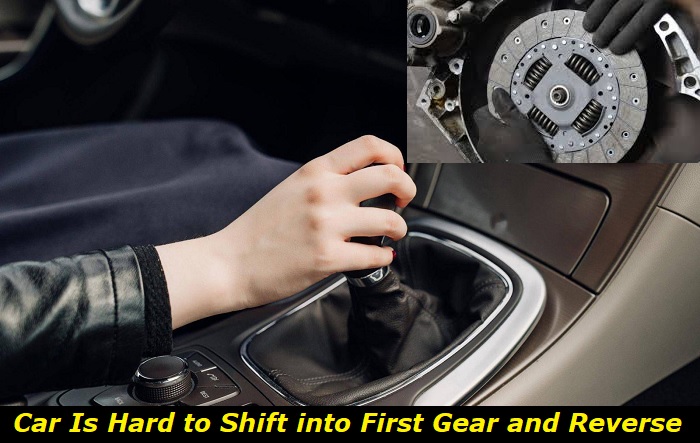When a clutch is working correctly, depressing the clutch pedal disconnects the transmission from the engine. The friction part of the clutch, which is the clutch disc, moves away from the turning flywheel, which rotates with the crankshaft.
Gear shifter problems highlights
- Level of importance:High
- Reasons:Shifter damage, wiring problems, software glitch
- Needed expertise:Medium
- Needed tools:Basic tools plus diagnostic tools
- Time taken:0.5-4 hours
- Can you drive? Yes, if it shifts
- Possible issues: No way to move your car, shifter is broken, need for tow truck.

Causes/ Reasons Your Clutch Disc Is Not Releasing
A few factors could cause the clutch disc to be stuck in the spinning flywheel, making it difficult to shift gears into first or reverse. This article will discuss some causes of this problem and ways to fix it.
1) Low Fluid in the Hydraulic System
The number one reason your clutch disc is not releasing is that the hydraulic system that runs the clutch leaks, thus creating a low fluid level. Although the clutch fluid could drop due to daily operation, you cannot rule out the possibility of a larger issue.
If you have refilled the clutch fluid more often than you should, your hydraulic system is leaking. A leak can manifest externally or internally. To ensure you have the facts right, look for wet spots under your vehicle, especially around related components. Wet areas on the ground confirm your clutch hydraulic system leaks.
Moreover, you should look for broken seals in the master cylinder or the slave cylinder. If you notice leaks around these areas, it is the reason your gar shifting into first or reverse has become difficult.
It is advisable to fix these leaks and refill the clutch fluid immediately to avoid further damage to the system. Be vigilant and service your clutch system regularly.
2) Check and Refill Your Clutch Fluid
If you checked and repaired all leaking areas in the clutch hydraulic system, it is time to top it up. Refilling your clutch fluid is easy. First, read your manual to ensure you use the correct fluid type.
To refill the clutch fluid reservoir, follow these simple steps.
- With a funnel in your hand, open the bonnet, and locate the clutch fluid reservoir. You will find it close to the firewall at the back of the engine. They have labels, but you can consult your manual to be sure.
- The fluid reservoir has minimum and maximum marks to show where the clutch fluid should lie.
- If you notice the fluid reservoir is below the minimum line or close to the line, open the cap and add fluid directly to the reservoir using the funnel in your hand. Ensure that it is at a considerable level.
- Ensure you do not add dust, dirt or debris when refilling the clutch fluid. Also, do not go beyond the top line.
- Replace the clutch reservoir cap. All done.
Monitor your clutch fluid levels regularly to catch such leaks before they escalate. If refilling your clutch fluid does not fix the "clutch disc not releasing" issue and you still have trouble shifting to gear one and reverse, move to the next cause below.
3) Worn Pressure Plate
Another reason you have trouble shifting gears to first or reverse is a worn clutch pressure assembly. Also called the pressure plate, the clutch pressure assembly holds the clutch disc to the spinning flywheel when the clutch pedal is free and releases it when you depress the pedal.
When this heavy metal tightly presses the clutch disc against the engine flywheel, power flows through the crankshaft into the transmission, then to the wheels through the driveshaft.
When you press the clutch pedal, the pressure plate releases the clutch disc, moving away from the engine flywheel. When you depress the pedal, you interrupt the power transmission from the engine crankshaft to the wheels.
As you drive, this heavy metal wears out. As a result, it can no longer do its job of pressing and releasing the clutch disc when you need it to. This means you can depress the clutch pedal, but the clutch disc remains attached to the engine flywheel, thus causing the gear shifting to first or reverse difficult and, sometimes, impossible. A worn pressure plate usually calls for complete clutch work.
Check out for the following symptoms to ensure you have a worn pressure plate.
- Grinding Noise As You Shift
Have you noticed grinding noises when shifting gears as you drive? This is a sign that you have a dead pressure plate. These noises could be due to a worn pressure plate or the synchros. The synchronizers are there to make gear-shifting smooth, especially between RPMs.
If you have trouble shifting to the first and reverse gears, these noises confirm that it is not your transmission synchronizers but the pressure plate that is the problem. You need to see a professional mechanic as soon as possible to diagnose the exact cause of the problem.
- Needing Higher RPMs
If you drive a stick shift, you already know how many RPMs your vehicle needs to hit a certain speed. When your clutch pressure plates begin to die, it causes your transmission to slip through gears. Your truck will ask for more RPMs to hit higher speeds when this occurs.
If this symptom shows up and you have trouble shifting to the first gear and reverse, your pressure plate is on its last leg. These signs go in hand with the grinding noise.
- Trouble Shifting Through Gears
The first sign of a worn pressure plate is difficulty shifting to gear one and reverse. When the problem worsens, it affects other gears. It makes it difficult to change through other gears as you drive.
These two factors are the primary reasons your clutch disc fails to release, making it troublesome to shift to gears one and reverse.
Should I Drive With a Sticking Clutch?
Although you might want to keep driving when you notice your clutch is sticking, it is not advisable. It is dangerous because the problem may escalate and break down entirely, leaving you stranded in the middle of the road.
Service your clutch system regularly to ensure you never reach this devastating point. Usually, many vehicles require clutch service every 60,000 miles. If you follow this routine religiously, you may never have to experience the issue of a sticking clutch or slipping transmission.
When you notice any problem with the clutch system, you should visit a professional service center as soon as possible.
How Much Does It Cost For Clutch Repair
Before going for clutch repair or replacement, it is essential to understand the parameters of determining how much you pay. You can visit your mechanic for price estimates or feel online forms for quotations.
The overall cost of repairing or replacing the clutch system will depend on the following:
- The make and model of your vehicle
- Where you drive
- Whether you will need brand-new or remanufactured parts
- Whether you will replace the whole clutch system or the clutch disc, pressure assembly, and other friction parts only
- Labor charges
It costs between $500 and $2,500 to repair your clutch system. It primarily depends on the type of car you own. Performance cars are more expensive to repair. Exotics and European vehicles follow suit. The Japanese economic cars are the cheapest to fix.
Additionally, a four-wheel drive vehicle will cost more than a two-wheel to repair its clutch. Irrespective of these factors, a successful clutch repair job involves the following:
- Clutch disc replacement
- Release and pilot bearings
- Replacing or resurfacing the engine flywheel
Conclusion
Besides being hard to shift to first gear and reverse, the clutch system can develop and manifest other problems. You can experience difficulty operating the clutch even on other gears. This means the situation is worsening and can soon leave you stranded on the road.
When you notice a problem with your transmission, visit a mechanic as soon as possible to diagnose and fix the problem.
About the authors
The CarAraC research team is composed of seasoned auto mechanics and automotive industry professionals, including individuals with advanced degrees and certifications in their field. Our team members boast prestigious credentials, reflecting their extensive knowledge and skills. These qualifications include: IMI: Institute of the Motor Industry, ASE-Certified Master Automobile Technicians; Coventry University, Graduate of MA in Automotive Journalism; Politecnico di Torino, Italy, MS Automotive Engineering; Ss. Cyril and Methodius University in Skopje, Mechanical University in Skopje; TOC Automotive College; DHA Suffa University, Department of Mechanical Engineering






Add comment